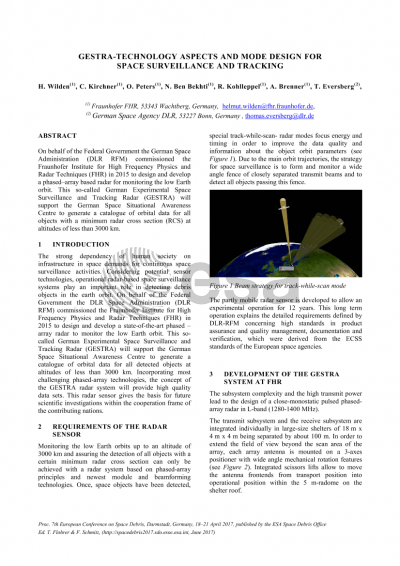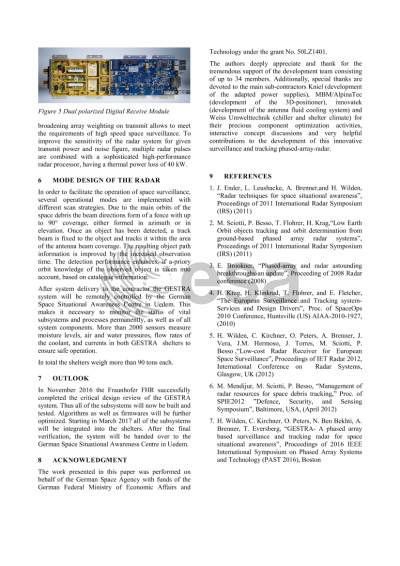Document details

Abstract
The increasing challenge of assuring undisturbed space infrastructure in the near future can only be met by surveillance and cataloging of space debris. In order to contribute to European efforts for space surveillance, the Federal Ministry for Economic Affairs and Energy (BMWI) of Germany assigned the Fraunhofer Institute FHR to develop and build a quasi-mobile solid state phased array based Radar system for surveillance of the low earth orbit having altitudes between 300 km and 3000 km. The so-called GESTRA (German Experimental Space and Tracking Radar) project is managed by DLR Space Administration and has a development time of 4 years. The radar will be remote controlled by the German Space Situational Awareness Centre in Uedem, led by civil and military guidance.
Incorporating state of the art technology, the concept of the new GESTRA radar system will provide high quality data sets, which will be publicly available to the scientific community for improving space debris detection algorithms.
The demand on simultaneously observing a large field of view combined with tracking a high number of objects can only be fulfilled by fully phased array sensors with high gain, extremely high transmit power and high sensitivity. Avoiding the risk of EMC-related damages, the system is designed to be a quasi-monostatic pulsed radar with the receive and transmit array being allocated in two distinct shelters (see artist view in Figure 1).
To improve the signal detection performance the receive system is designed to be a dual polarization array. Both phased arrays are mounted on 3D positioners in order to select the chosen space volume for surveillance.
In order to cope with high transmit power, cavity backed stacked patch antennas were chosen for single elements.
The single radiators of both planar array antennas are directly connected to the modules being assembled via a plank concept to optimize the thermal design and ease the maintenance of the system. Both, the transmit and the receive planks are liquid-cooled to provide a temperature control and increase in life time. The transmit modules are designed for pulsed and CW operation with highest state of technology solid state high power transistors. Both antenna apertures cover a diameter of 3 m with a weight of more than 22 tons including positioner.
Each shelter has a size of 18 m x 4 m x 4 m and an associated radome with a height of 5 m accommodating the complete infrastructure for autonomous operation of the receive or transmit subsystem in L-Band.
Due to the system mobility the individual frequency requirements for the different sites have to be met by flexible receive principles. This will be realized by digital receive modules incorporating software defined radio techniques. Furthermore, the data acquisition is performed on RF. Programmable center frequencies, filter curves, beam shapes, simultaneous beam directions and bandwidth allow an optimum of flexibility in waveform switching and radar resource management.
The relevant surveillance modes with different volume parameters generate a beam fence in space in order to detect objects passing this fence. Once an object is detected, a special tracking procedure with adapted beams in shape and waveform will be initiated to get path information of the objects orbit parameters. Deriving the object information with high accuracy and sensitivity within a performant radar processor, a large number of objects can be observed simultaneously.
The presentation will describe some key technology aspects of the system and provides information on the beamforming capabilities and mode designs.
Preview




